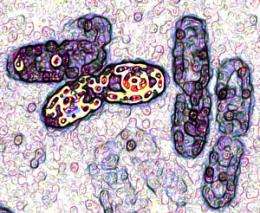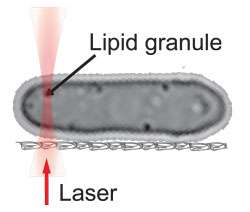Dynamic systems in living cells break the rules

There is considerable interest in understanding transport and information pathways in living cells. It is crucial for both the transport of, for example, medicine into cells, the regulation of cell life processes and their signalling with their environment. New research in biophysics at the Niels Bohr Institute shows surprisingly that the transport mechanisms do not follow the expected pattern. The results have been published in the scientific journal Physical Review Letters.
The researchers studied fat molecules which are naturally occurring in cells. Using a special state-of-the-art instrument, an optical tweezer, they were able to hold onto the small fat molecules inside living yeast cells using an extremely focused laser light. By measuring the movement of the fat molecules over several hours they could observe that they were not behaving as expected.
The laws of physics for motion
In the world of physics, there is something called Brownian motion. Ordinary Brownian motion describes how a substance passively spreads in a liquid. For example, when you pour a spoonful of sugar into a glass of water the sugar will distribute itself evenly after a while. Would fat molecules behave 'ordinarily' and simple distribute itself evenly in the cell fluid?
In any case, the researchers had expected that the Ergodicity theorem (tenet), which is a generally recognized law of nature, would be adhered to. The Ergodicity theorem predicts that statistically, the result of throwing 10 dice once would have the same average distribution as throwing one die 10 times.
The Ergodicity theorem is expected to apply for anomalous transport processes in unorganized materials, for example, biological systems. The researchers expected therefore, that if you observe the transport of fat molecules in many cells at once, then you would get the same result as by looking a single cell repeatedly over a long period of time. You expect a pattern.
Breaks common wisdom
"But neither the one nor the other common wisdom held true. It turned out the fat molecules broke with all the patterns. Our analysis of the spreading of liquid fat granules in living yeast cells showed that not only was the distribution abnormal, but that the movement in the relevant time period was also in conflict with the statistics for ergodicity. They almost have their own will", explains Lene Oddershede, associate professor in the biophysics group, Optical Tweezers at the Niels Bohr Institute at the University of Copenhagen. The experimental studies were performed here, while researchers from DTU as well as Germany and Israel have worked with the theoretical calculations.

The conclusion is that controlling living systems is more complicated than previously thought and that the basic concepts in statistical physics must be replaced when analysing certain aspects of biomolecular dynamics in cells.
"We have gained very important knowledge. What we thought would apply, did not hold up at all, so now we need to find a completely new law for the physics in living organisms. Our goal is to discover how the cell signals and how it communicates both internally and with its environment", explains Lene Oddershede.
More information: prl.aps.org/abstract/PRL/v106/i4/e048103
Provided by University of Copenhagen

















